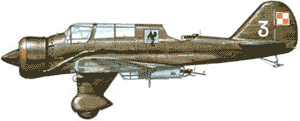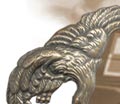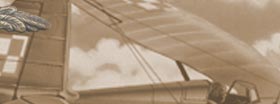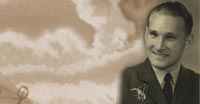The Polish
Airforce 1918 – 1939
The
modern history of Poland is reflected in its pioneering spirit
towards aviation in the inter-war years’. While the Twenty Years
of Independence (Niepodelosc) marked the re-emergence of Poland
at the Treaty of Versailles, no other re-emerging nation received
such gratuitous abuse and derision (Davies, 1981) from diplomats
and politicians across Europe. While Poland re-emerged from the
vacuum left in central European politics through the collapse
of the Austro-Hungarian Empire, its very existence was to be repeatedly
challenged through to the latter part of this century.
As
a divided nation Poles had fought for and against the major armies
of Europe. Within three years of its re-emergence, Poland had
fought forces from Germany, Lithuania, the Ukraine and Russia
over the sovereignty of land. While Polish politicians like Dmowski
wanted frontiers based upon ethnic boundaries, many Poles sought
the former glory of the Polish – Lithuanian Commonwealth which
had existed at the end of the eighteenth century. The ‘Polish
Question’ had dogged politicians both during war and at the Treaty
of Versailles. Friction caused by complex ethnic boundaries and
contested cities, ultimately led to the outbreak of war.
The
first operational flight of the Polish Airforce took place on
5th November 1918 from Lewandówka airfield against
Ukrainian nationalistic forces attacking Lwów (Zamoyski,
1995). Janusz de Beaurain and Stefan Bastyr piloted a plane cannibalised
from parts of other aircraft that was assembled while mechanics
and the airfield was under attack. Painted in the Polish colours
of white and red, it made its first sortie and the emergence of
a new fighting arm. Many Poles on returning ‘home’ after the Great
War brought new skills in aviation whether they were pilots, mechanics
or engineers. Contemporary historians tend to forget or minimize
Polish achievement throughout history. It was a Pole who built
the first helicopter in Russia in 1903. Prince Stanislaw Lubomirski
had set up a flying school and aircraft works at Mokotów,
just outside Warsaw and built the first Polish designed plane
in 1910. Also, in the same year Grzegorz Piotrowski had flown
a record 23 miles over water from St. Petersburg to Kronstadt.
In 1914 Jan Nagórski made the first Arctic flight. While
Flight had captured the hearts and minds of many young men, key
members of the military were a little more ambivalent towards
the role and effectiveness of an airforce. Numerous Poles were
introduced to the delights of flight either through pleasure trips
or from ‘joining-up’ as this was cheaper than private lessons.
Not all introductions to flying or flight were in this manner
as the following story in Tygodnik Podhalanski reported.
Zenon Krzeptowski and a group of friends
were playing in the lush meadows around Zakopane at the foot of
the Tatry mountains’. A gentleman flying an early bi-plane found
himself ‘shot-down’ by a group of schoolboys and their
catapults. Most of the culprits fled, leaving Zenon to face the
wrath of his father, Jan and forfeiture of his pocket money.

As
a fledgling state, Poland was fortunate in that large amounts
of war material and ordnance which had been abandoned by the various
retreating forces, particularly the Germans who left disassembled
aircraft in hangars at Poznan (Koniarek, 1994). While Marshall
Jozef Pilsudski amalgamated and remodelled a new army
through the use of French military advisors, the Polish Airforce
(Lotnictwo Wojskowe) began to take shape. French military advisers
also played an important role and so did a number of key individuals.
Lieutenant Stefan Stec flew a ‘liberated’ Fokker D.V to Warsaw
in November 1918 decorated in his personal colours of the red
and white chequerboard with a border of complimentary colours
which became adopted as the national insignia (Koniarek, 1994;
Zamoyski, 1995). Two Americans, Major Cederic E. Fauntleroy and
Captain Merian C. Cooper volunteered to fight and help train airmen
after observing the Allies (which included Polish units) marching
up the Champs-Elysées on 14th July 1919 after
hearing the Soviets were threatening Poland. No. 7 Squadron largely
consisted of American volunteers, some fifteen in all (Koniarek,
1994; Zamoyski, 1995) who fought with distinction during the Polish-Bolshevik
War 1919 – 1921. The Squadron was named after Tadeusz Kosiuszko,
the Polish general who fought in the United States during the
Revolutionary War. Lieutenant Elliot Chess designed the famous
squadron insignia. The thirteen blue stars and stripes represent
the original American colonies. In the centre, crossed scythes
reforged as lances and a four-cornered hat represents Poland’s
insurrection against Russia in the 19th Century (Koniarek,
1994). (No. 7 Kosciuszko Squadron flew with distinction as part
of the famous 303 Squadron in the Second World War).
As
a fledgling state, Poland could not match the
inter-war arms race between Germany, Britain, France, Italy
or Soviet Russia. The early years of Lotnictwo Wojskowe
saw the development of Europe’s second largest airforce under
the direction of General Wlodzimierz Zagorski and later General
Ludomil Rayski who may be regarded as the driving force behind
Poland’s military aviation industry. By 1929 the PZL (Panstwowe
Zaklady Lotnicze) P.1 had flown. This all metal, gull winged aircraft
was an advanced fighting machine and largely went for export to
countries like Rumania, Bulgaria, Turkey and Greece. By 1936 15
Squadrons were equipped and then General Ludomil Rayski shifted
the production of aircraft towards bomber production at the expense
of fighter development and up-grading. In 1934 work had begun
on the PZL P.37 Los bomber which began to enter service in 1938.
The relatively small defence budget was no match for the European
arms race and by the late 1930s Poland had slipped behind Russia,
Britain, France and Germany (Zaloga and Madej, 1991). Contemporary
historians like Liddell-Hart portrayed Poland as ill-prepared
and weak without taking into account that large-scale industrialization
had not started in Poland until the mid-1920s. Between 1936 –
1939 military capital expenditure accounted for 70% of all domestic
capital investment and represented a Defense Budget of 800 million
Zloty (Zaloga and Madej, 1991). The small oil reserves in Galicia
near Boryslaw were strategically significant to both the German
and Soviet military high-command, but production was limited.
For such a young country much had been achieved within this fledgling
democracy despite political turmoil and numerous border disputes
in the early 1920s. Following Pilsudski’s death in 1935, the military
junta led by General Rydz-Smigly did not have extensive popular
support.
Operational
Doctrine
Much
of the operational doctrine was based
upon French strategic planning which by the late 1930s was inadequate
to deal with Germany’s mechanized war (Zaloga and Madej, 1991).
Each army was allotted its own air units, usually made up of two
squadrons of P.7 fighters or P.12 air defence/ ground attack aircraft.
In addition one reconnaissance squadron made up of eight to ten
P.23 Karas light bombers and one or two observation squadrons
made up the Lotnictwo Wojskowe attachments to the army.
While
Poland had some 300 fighters (Zaloga and Madej, 1991; Koniarek,
1994; Zamoyski, 1995) only 10% were in combat condition. The remainder
were either in a training role or undergoing repair prior to the
outbreak of war. The Karas bombers numbered around 240 and never
really fulfilled its role as a light bomber or ground attack aircraft.
The P.37 Los bomber was more advanced in design, but only 75 available
for combat duty in 1939.
War
in the Air 
Numerous
authors (Davies, 1981, Zaloga and Madej, 1991; Koniarek, 1994;
Zamoyski, 1995) have attempted to correct historical myth surrounding
the role of the Lotnictwo Wojskowe. The airforce was not
destroyed on the airfields on the 1st September 1939.
Most aircraft were dispersed to secret airfields and the Luftwaffe
primarily shot-up and bombed empty airfileds obscured by early
morning mist. Air defences concentrated on air cover over Warsaw
as the prime objective that enabled the Luftwaffe air superiority
to disrupt mobilization of the army. The military high command
requested low-level raids on advancing German columns that proved
to be very wasteful in planes. While most air units quickly retreated
into the heartland of Poland, spares and fuel became an increasing
problem. Communication between units and the army broke down and
in some cases units were requested to carry out tactical support
against an army which could outgun them or take on a superior
airforce. Pilots and ground-crew fought heroically with limited
resources and often found ‘friendly-fire’ was as lethal as taking
on the enemy (Zamoyski, 1995). As planes moved from airfield to
airfield, ground crews struggled to rendezvous and quite often
became separated for up to three days before rejoining their squadrons.
These experiences shaped tactical policy which were put to good
effect, but not in this theatre of the war.
On
the 3rd September onwards all units were to withdraw
to southeastern Poland in order to re-group. All personnel and
reservists had by now been called up. By the 5th September,
the physical intervention by Britain and France had not materialized
and the airforce had lost 30% of its aircraft. Zamoyski, (1995)
pointed out that 14 Hurricanes and 36 Fairey Battles having being
loaded aboard ships in Liverpool bound for Gdynia were rerouted
to the Rumanian port of Galti on the Black Sea once hostilities
commenced. On the 10th September 200 pilots and technical
staff were ordered to Rumania to collect replacement machines.
Unfortunately, Rumania under German pressure rescinded its alliance
with Poland and became neutral while 6,000 airforce personnel
massed on the border. The ship carrying its valuable cargo had
passed Gibraltar as Rumanian neutrality was announced and unknown
to the Poles, the ship was once again re-routed. From the 16th
September onwards, combat casualties to aircraft and personnel
escalated with squadrons being annihilated or simply running out
of fuel and spares. On the 17th September 100 war planes
and 50 civilian aircraft flew into Rumania to an airfield at Galati.
The crews suddenly realized the war was over and that Rumania,
Britain and France had not supported them in their hour of need.
Most airmen were reasonably well treated. Polish army units began
to cross the Rumanian border shortly afterwards. In Eastern Poland,
the Polish army and airforce were engaging both the German and
Soviets and continued to fight hard until 6th October.
In
the aftermath, it appeared significant numbers of military
personnel had escaped and started their campaign in exile.
The navy had escaped and Poland’s gold reserves too thanks to
the planning of General Rayski. 900 airforce personnel had made
their way to Hungary and approximately 1,000 to the Baltic States
of Latvia and Lithunia. Another 1,500 had been captured by the
Soviets and sent to the gulags – many did not survive (Anders,
1949; Zamoyski, 1995). Security at the internment camps was poor
and the inmates too keen to get to France and Britain to fight
while in exile. 90,000 Polish military personnel were to be clandestinely
removed from the Balkans through an underground network. Britain
was acutely short of trained airmen who were given priority together
with the elements of the Enigma decoding material Zamoyski, 1995:39).
Any correspondence
should be addressed to Julian Hoseason and e-mailed to:jhoseason@paston.co.uk. Any additional
material or stories would be gratefully received.
|





